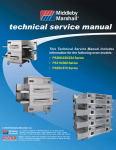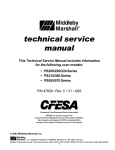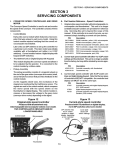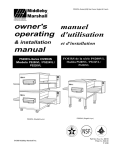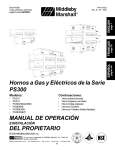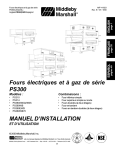Download Middleby Marshall PS520E Operating instructions
Transcript
Middleby Cooking Systems Group • 1400 Toastmaster Drive • Elgin, IL 60120 • USA • (847) 741-3300 • FAX (847) 741-4406 Instructions for Service Kit 58504 Digital Temperature Controller Installation, Programming and Troubleshooting Instructions KIT COMPONENTS Qty. P/N 1 58388 1 58955 Description Digital Temperature Controller (On/Off Gas & Electric, PID Gas, and Variable Pulse Electric operating modes), with mounting brackets Instructions TABLE OF CONTENTS Controller Types ............................................................................................... 2 Before You Begin ............................................................................................. 3 Installation ........................................................................................................ 3 Electrical Connections ..................................................................................... 4 Jumper Setting ................................................................................................. 6 Programming ................................................................................................... 6 Diagnostic Error Messages ............................................................................. 8 Operating Instructions (to be left with customer after installation) ...................... 9 Middleby Cooking Systems Group • 1400 Toastmaster Drive • Elgin, IL 60120 (847) 741-3300 • FAX (847) 741-4406 © 2002 Middleby Marshall. cjz P/N 58955 • Rev. B• V3 • 1/06 Page 1 of 10 Controller Types This Kit includes one Digital Temperature Controller (P/N 58388) that can operate at 120-240V, and can be programmed to operate in on-off, PID, or variable pulse modes. The Controller is shown in Figure 1G, below. By following these instructions, the Controller can be installed into any Middleby Marshall oven equipped with the following Controllers. • P/N 28071-0012 (Fig. 1A) Analog Temperature Controller without high-limit and cooldown functions, operating at 120V, on-off mode only. • P/N 28071-0018 (Fig. 1A) Analog Temperature Controller with high-limit and cooldown functions, operating at 120V, on-off mode only. • • • P/N 34983 (Fig. 1B) Analog Temperature Controller without high-limit and cooldown functions, operating at 120V, on-off mode only. Used on PS200VL models. As of 12/01, P/N 34983 is still available and should be used on these ovens if possible. P/N 28071-0027 (Fig. 1C) Digital Temperature Controller with blue plastic faceplate, operating at 120V, on-off mode only. P/N 28071-0028 (Fig. 1D) Digital Temperature Controller with gray rubber faceplate and buttons with text, operating at 120V, on-off mode only. • P/N 28071-0028 (Fig. 1E) Digital Temperature Controller with gray rubber face plate and buttons with symbols, operating at 120V, onoff mode only. • P/N 30871 (Fig. 1E) Digital Temperature Controller with gray rubber face plate and buttons with symbols, operating at 208-240V, on-off mode only. Used on early PS360WB70 and some CE oven models. • P/N 32571 (Fig. 1E) Digital Temperature Controller with gray rubber face plate and buttons with symbols, operating at 208-240V, PID mode only. Used on early PS360EWB. • P/N 36021 (Fig. 1F) Digital Temperature Controller with gray face plate (steel trim on edges), operating at 120-240V, selectable onoff or PID modes. • P/N 36056 (Fig. 1G) Digital Temperature Controller with black plastic face plate, operating at 120-240V, selectable on-off or PID modes. Figure 1 A C D B E F G This Kit CANNOT be installed in a PS536 oven equipped with the P/N 44783 (variable pulse electric) or P/N 44823 (PID gas) controller shown below. H Page 2 of 10 WARNING BEFORE PERFORMING ANY SERVICE WORK, THE ELECTRICAL POWER SUPPLY AND THE GAS SUPPLY MUST BE TURNED OFF. Before you Begin 1. This Temperature Controller requires a current-version thermocouple for proper operation. Check that the thermocouple(s) installed in the oven match the current three-lead, flanged versions BEFORE you begin to install the Temperature Controller. See Figure 2. If the oven is not equipped with current thermocouples, you should replace them BEFORE you install the new Temperature Controller. P/N 33984: Thermocouple kit for PS300-series, PS555 and PS570 P/N 33985: Thermocouple kit for PS200-series and PS536 Figure 2 Cable (3 leads) flange Current thermocouple Cable (2 leads) Obsolete 2-lead thermocouple clip Installation 1. Access the back of the existing temperature controller. Tag each wire that connects to the controller with its terminal number. These numbers will be used later to wire the new controller. 2. Disconnect all wires from the terminals on the temperature controller. Be sure to retain any jumpers that are removed. 3. Remove the controller and sleeve from the oven as follows: • For analog controllers P/Ns 28071-0012 and 28071-0018 (Fig. 1A), remove the two bracket screws on the back of the control. Then, remove the bracket. Pull the controller and sleeve out through the front of the oven panel. • For all other controllers, remove the two screws and brackets that hold the controller in place. Then, pull the controller and sleeve out through the front of the panel. Page 3 of 10 4. Check that the new controller is mounted into its sleeve. Then, slide the assembly into the opening in the panel from the outside. Check that the controller is upright, with the display on top and the keypad on the bottom. 5. Locate the rectangular holes on the top and bottom of the new controller’s sleeve. Attach the two kitsupplied mounting brackets against the inside panel of the oven, and into the holes in the sleeve, as shown in Figure 3. Check that the heads of the screws point to the rear of the controller. 6. Tighten the two screws evenly until the lip of the sleeve is seated tightly against the panel. 7. If there is a protective clear plastic strip on top of the display, remove it at this time. Figure 3 Temperature controller is pre-installed into sleeve and is upright Control panel Bracket clips and screw heads point to REAR of controller Electrical Connections 1. Wire the new controller as follows: • If you are replacing an Analog Temperature Controller, P/Ns 28071-0012 or 28071-0018 (see Fig. 1A), refer to Figure 4A for a listing of the new terminal numbers. • If you are replacing an Analog Temperature Controller P/N 34983 (Fig. 1B - PS200VL models only), refer to Figure 4B for a listing of the new terminal numbers. • If you are replacing any Digital Temperature Controller, simply reconnect ALL of the original wires and jumpers to the same terminals, as all terminals are numbered the same. EXCEPTION: Controller P/N 32571(Fig. 1E - used on early PS360EWB ovens only) uses Terminals 4 & 5 for the mA output to the amplifier board. The current controller uses Terminals 15 & 16 for these connections, as shown in Figure 5A. Page 4 of 10 Figure 4a Figure 4b Analog temperature controller (P/Ns 28071-0012 and 28071-0018) terminals Analog temperature controller (P/N 34983) terminals New temperature controller terminals New temperature controller terminals Not used on some gas and electric ovens Not used Not used. PS200VL ovens have a separate high limit module and do not include a cooldown feature. Not used Not used Not used Not used. PS200VL ovens do not include a modulating gas system. Not used. These terminals provide PID output (gas ovens with modulating valve) or variable pulse output (electric ovens with variable pulse system). Neither of these systems were available with ovens equipped with these controllers. Terminal for 28071-0012 and 28071-0018 1 2 5 6 L2 L1 G 13 14 15 16 --- Terminal for 34983 TC+ TCCOM NO L2 L1 G ------- Terminal for 46837 8 7 5 4 L2 L1 9 10 11 12 15 16 Description + TC - TC Input to Temperature Control Relay Output to High Flame Solenoid or Heater Contactors Neutral Power Ground Input to Cooldown Relay Output from Cooldown Relay Input to High Limit Relay Output from High Limit Relay PID or Variable Pulse Output PID or Variable Pulse Output Figure 5a Figure 5b Modulated Gas Output System Variable Pulse Output System 4-20mA input Amplifier board Modulating valve Relay 20VDC pulsed output 0-24VDC output NOTE: Controller P/N 32571 used Terminals 4 & 5 for the 4-20mA input to the amplifier board. These connections must be moved to Terminals 15 & 16 on the new controller as shown. NOTE: Safety switches may be placed between the temperature controller and the relay on some oven models. 24VAC input Page 5 of 10 Jumper Setting Loosen the Phillips screw at the bottom center of the faceplate. Then, pull the controller out of its sleeve. Next, access the jumper shown in Figure 6. This jumper affects the signal that is output from Terminals 15 and 16. The jumper MUST be set to the correct position for proper operation of the controller. CAUTION If the jumper is incorrectly set, the oven will be unable to properly maintain temperature. In addition, DAMAGE MAY OCCUR TO THE CONTROLLER AND OTHER OVEN COMPONENTS. Always make sure that the jumper is correctly set BEFORE restoring power to the oven! • • • For gas ovens equipped with the modulating gas system, For PS540 Electric & PS555 Electric, the jumper must be set to the “W1” position. This instructs the controller to send a variable-current 4-20 mA signal from Terminals 15 and 16 to the amplifier board. The board converts this to a 0-24VDC signal which is sent to the modulating valve. The valve regulates the gas flow according to the need for heat to maintain the set point. For gas ovens, you should always check inside the machinery compartment to see whether a modulating valve is present in the unit before setting this jumper. For electric ovens equipped with the variable pulse system, the jumper must be set to the “W2” position. This instructs the controller to send a constant-current, pulsed 20VDC signal to the relay. Once every four seconds, the signal “pulses” on proportional to the need for heat to maintain the set point. The PS536 Electric oven (as of 1/02), the PS520E & the Blodgett 1820S uses the variable pulse system. Other oven models equipped with this system will be announced by Middleby as they become available. For all other ovens - gas or electric - that use the on-off system, the jumper may be set to either position. Figure 6 After the jumper has been properly set, replace the controller into its sleeve and tighten the screw. Programming Jumper is set to the “W1” position for gas ovens with modulating gas system Jumper is set to the “W2” position for electric ovens with variable pulse system 1. Restore electrical power to the oven. 2. Refer to Figure 7. Set the following options, according to the customer’s preferences: • Set Point locked or unlocked • Degrees Fahrenheit or Celsius • Set Point or Actual Temperature display 3. Set the controller to PID or On-Off operating mode. Choose the PID mode for BOTH gas ovens with the modulating system AND for electric ovens with the variable pulse system. 4. Adjust the Set Point according to the customer’s specifications. 5. If the PID operating mode was chosen, perform an Auto-Tune calibration as per the instructions in Figure 7. 6. Check that the customer is familiar with the operation of the controller. The last page of these instructions includes an operating guide Page 6 of 10 for the controller. Remove this page and leave Page 7 of 10 Figure 7 Temperature Controller Service Instructions Diagnostic Error Messages The controller runs background tests during normal operation. If any problems occur during the tests, an error message flashes in the display. A listing of these diagnostic error messages is shown below. Flashes on the display (alternating with the temperature) indicating that the internal diagnostic test has failed. The oven temperature has not reached 200°F/93°C within 15 minutes of startup. On gas ovens, this is usually a result of the burner not lighting. Caused by an open in the thermocouple circuit. Polarity of the thermocouple leads is reversed. 1. Turn the Blower Switch (HEAT Switch for PS536 ovens with the twoswitch configuration) OFF for 2 minutes. 2. Turn the Blower Switch (or HEAT Switch, as per Step 1) ON. 3. If necessary, repeat Steps 1 and 2 up to two additional times. 4. If the problem does not clear after 3 attempts, replace the controller. 1. Turn the Blower Switch (HEAT Switch for PS536 ovens with the twoswitch configuration) OFF for 2 minutes. 2. Turn the Blower Switch (or HEAT Switch, as per Step 1) ON. 3. If the problem does not clear, contact the Middleby Technical Service Department for assistance. 1. Check that the thermocouple leads are properly connected to Terminals 7 & 8 of the temperature controller. 2. Check the continuity of the thermocouple at room temperature. You should measure 9-20 Ohms of resistance. 3. If the reading was outside the correct range, the thermocouple has an open. Remove and replace the thermocouple. If the reading was inside the correct range, contact the Middleby Technical Service Department for assistance. 1. Check the polarity of the thermocouple leads. The red wire (-) should be attached to Terminal 7 on the temperature controller. The white wire (+) should be attached to Terminal 8. 2. If the polarity connections are incorrect, connect the thermocouple properly. If the polarity connections are correct, replace the thermocouple. Page 8 of 10 Digital Temperature Controller P/N 46837 Operating Instructions Display Shows the Set Point or the Actual Temperature in degrees Fahrenheit (F) or Celsius (C). "HEAT ON" Light Lights when the burner or heating elements, as appropriate for the oven model, are in operation. "SP LOCK" Light Lights when the set point is locked out from changes. This setting can only be changed by service personnel. "SET PT" (setpoint) Light Lights when the set point is shown in the display. "ACTUAL TEMP" Light Lights when the Actual Temperature is shown in the display. OVERTEMP Light Lights when the oven temperature is greater than 650°F (343°C). Temperature Key Press this key once to view the Actual Temperature in the Display. Unlock Key Press this key together with the Set Point Key to allow the Set Point to be changed. Changes can only be made for 60 seconds. Service Key For use by service personnel only. Up Arrow and Down Arrow Keys Press these keys to adjust the Set Point up or down. If the Set Point will not change, refer to Set Point Key and Unlock Key. Set Point Key Press this key together with the Unlock Key to allow the Set Point to be changed. Changes can only be made for 60 seconds. Middleby Cooking Systems Group • 1400 Toastmaster Drive • Elgin, IL 60120 (847) 741-3300 • FAX (847) 741-4406










